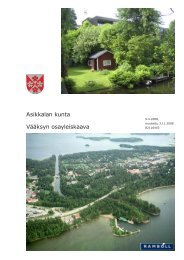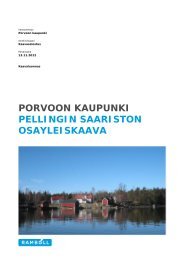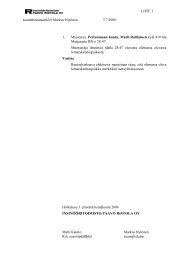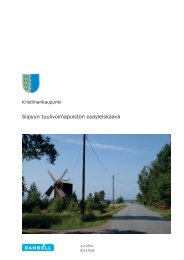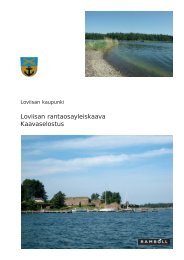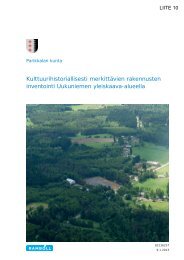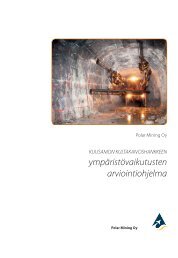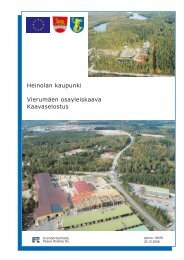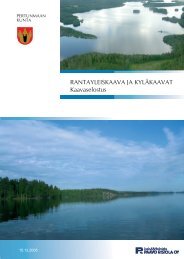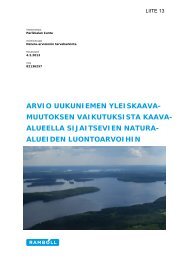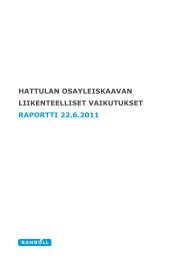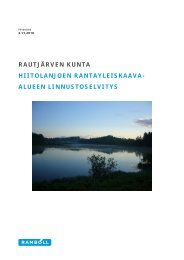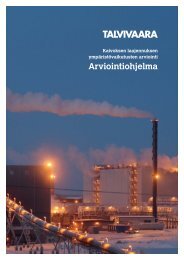Paper - Ramboll Finland Oy
Paper - Ramboll Finland Oy
Paper - Ramboll Finland Oy
You also want an ePaper? Increase the reach of your titles
YUMPU automatically turns print PDFs into web optimized ePapers that Google loves.
ENVIRONMENTALLY FRIENDLY SYSTEMS TO RENOVATE SECONDARY ROADS.<br />
LIFE-ENVIRONMENT PROJECT: KUKKIA CIRCLET<br />
LIFE02 ENV/FIN/000329<br />
D.Sc.(Tech) Pentti Lahtinen, <strong>Ramboll</strong> <strong>Finland</strong> <strong>Oy</strong><br />
M.Sc. (Eng) Hannele Kulmala, Finnish Road Enterprise<br />
M.Sc. (Eng) Seppo Kolkka, Hämeen Kuljetus <strong>Oy</strong><br />
Lic.Sc.(Tech) Aino Maijala, <strong>Ramboll</strong> <strong>Finland</strong> <strong>Oy</strong><br />
ABSTRACT<br />
The project Kukkia Circlet is about the demonstration of sustainable, environmentally friendly<br />
methods and processes to renovate and maintain secondary road network. The project innovations<br />
are based on earlier R&D in <strong>Finland</strong>, including new types of road construction materials based on<br />
industrial by-products, different types of applications and structures for the new materials, new<br />
types of equipment for the mixing of the materials, and in-detail-controlled construction processes<br />
to ascertain the target quality and economic benefits of the renovation. The applications based on<br />
the by-products include stabilisation of existing road courses, structural courses to compensate for<br />
the conventional stone courses, a groundwater protection structure on the side of a road, and light<br />
traffic paths. The pilot constructions have been implemented partly in the summer 2002 and partly<br />
in 2003, and the follow-up will continue at least to the end of 2004. The society will benefit from<br />
the sustainable construction system and durable quality of the secondary roads, economical and<br />
efficient maintenance of the secondary road network, and increasing safety of the pedestrians and<br />
cyclists by the side of the narrow roads. The project (2001-2004) is co-financed by EU Life-<br />
Environment (Life02 ENV/FIN/000329), Finnish Road Administration and the partners. The paper<br />
will present the project and the results obtained so far under the theme about waste recycling, utilisation<br />
and management.<br />
1(6)
BACKGROUND<br />
The main problems in the background of the project include: the constant inferior quality and frost<br />
damage of the gravel roads (see Figure 1) because of the high costs of effective conventional renovation;<br />
the dangerous narrow road sides for the cyclists and pedestrians in the rural and sparsely<br />
populated areas because of the high costs of conventional light traffic path structures; the high volumes<br />
of non-renewable stone resources exploited for the conventional road maintenance and renovation;<br />
the environmental problems in connection with the exploitation of natural stone resources<br />
from rocks, hills or eskers; and the increasing societal and legislative constraints to the exploitation<br />
of natural stone resources.<br />
OBJECTIVES AND EXPECTED OUTCOME<br />
1.<br />
Frost damage of a gravel road (Luopioinen 2002)<br />
Kukkia Circlet will combine all the know-how that has been obtained earlier during many different<br />
types of R&D projects on the use of industrial by-products in road construction. The project aims at<br />
showing that there are available new, controlled, sustainable and efficient road construction processes<br />
that benefit the different European societies with different types of problems to maintain and<br />
renovate secondary roads. The project also aims at the elimination of the major restrictions to the<br />
utilisation of certain industrial by-products (like ashes and paper sludge of the forest industry or<br />
certain process waste of the chemical industry) in the soil construction.<br />
The outcome will be the new sustainable methods and processes for the improvement of the secondary<br />
road network in Europe. In the long term the exploitation of the project results will significantly<br />
reduce the exploitation of non-renewable natural resources, the amount of waste and the need<br />
for deposit sites in Europe. The results can also be used in the work of European standardisation and<br />
legislation concerning the use of industrial by-products in construction. The dissemination will be<br />
supported by video / dvd and the Guide publication that have been produced during the project, and<br />
by participation in workshops like this arranged by ISEG (June 8-10, 2004, Helsinki – Espoo).<br />
2(6)
ORGANISATION<br />
The leading partner and co-ordinator of Kukkia Circlet is the Finnish Road Enterprise. Other partners<br />
are Luopioinen Municipality, Council of Tampere Region, Finncao <strong>Oy</strong>, Georgia-Pacific <strong>Finland</strong><br />
<strong>Oy</strong> and Kemira <strong>Oy</strong>j Kokkola. The main part of testing and follow-up as well as the planning<br />
of the new structures for the pilots has been subcontracted from <strong>Ramboll</strong> <strong>Finland</strong>’s R&Dlaboratory.<br />
ACTIVITIES<br />
Kukkia Circlet project is testing the innovative processes to renovate gravel roads, and to construct<br />
groundwater protection and light traffic path structures on the sides of the gravel roads. The special<br />
focus will be on the logistics, mixing and other work methods. The project will also assess the<br />
long-term properties, environmental impact and costs of the new applications in comparison with<br />
the conventional road structures. The focus of activities involve several tasks and pilot constructions<br />
that have been carried out during 2002 and 2003. Information about the progress of the project<br />
and the project results has been spread through the information media and with help of webpages<br />
for the project. The final technical report on Impact Assessment and the Guide publication<br />
will summarise all the know-how about the new renovation process and the special structures.<br />
The pilots involve following tests and applications:<br />
a) Stabilisation of existing old structural courses with help of binder admixtures based on fly ash.<br />
This will improve the bearing capacity of the gravel road. This application has been implemented<br />
during the summer 2002 (see figures 2 - 7);<br />
b) Renovation of a frost damaged road with help of fibre-ash structural road courses. This has been<br />
implemented in summer 2003, see figures 8 and 9. This will solve the problems of heavy frost<br />
damage of the gravel road;<br />
c) Construction of a groundwater protection structure using fibreclay, see figures 10 and 11. This<br />
has been implemented in the autumn 2004. This will become a cost-effective alternative hydraulic<br />
barrier.<br />
d) Construction of new alternatives for light traffic paths with fibre-ashes and geo-reinforcements,<br />
see the different types of applications in figures 12-15. Also these have been implemented in the<br />
summer 2003.<br />
Please, follow our web-sites and the information on events: www.tieliikelaitos.fi/5_4.asp<br />
3(6)
2.<br />
Production of the fly-ash binder admixtures. A<br />
new type of mixing station<br />
4.<br />
Spreading of the binder admixture<br />
6.<br />
Compaction<br />
3.<br />
Transport of the binder admixture from the mixing<br />
station to the construction site.<br />
5.<br />
Stabilisation with a milling cutter<br />
7.<br />
Covering the stabilised road with filtercakestabilised<br />
crushed stone<br />
4(6)
Spreading of fibre-ash on the planed road surface<br />
8.<br />
10.<br />
Spreading of fibreclay on the bottom after the<br />
removal of soil (that will be used to cover the<br />
sealing course, later)<br />
9.<br />
Compaction<br />
11.<br />
Compaction of the fibreclay course<br />
5(6)
12.<br />
Spreading of fibre-ash on the planed safety<br />
lane extension and a georeinforcement<br />
(geonet), and using the support plate for the<br />
spreading works. After spreading, the fibre-ash<br />
course will be smoothed out and the geonet<br />
sides will be turned on it (to make a “bag”).<br />
14.<br />
Starting the separate light-traffic lane on a soft<br />
soil (peat) area by pre-loading the site in the<br />
early spring. A gravel course has been covered<br />
by a geotextile, and the crushed aggregate<br />
course is being spread on this.<br />
13.<br />
Compaction of the fibreclay course that is inside<br />
the geonet “bag” and covered with a protective<br />
course of crushed aggregate<br />
15.<br />
Finishing of the separate light-traffic lane after<br />
spreading and compacting of the fibre-ash course<br />
and before making the final surface.<br />
6(6)



